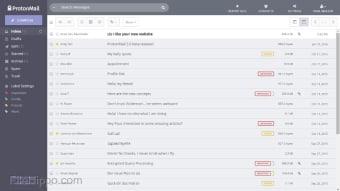

So, I don’t have much use for this application. rpm file.Įlectron Mail Setting My Thoughts on ElectronMail To install it, just enter sudo snap install electron-mail.įor all other Linux distros, you can download a. There is also a Snap available for ElectronMail. for Arch and Arch-based distros, you can install it from the Arch User Repository. How to install ElectronMailĬurrently, there are several options to install ElectronMail on Linux. ProtonMail and Tutanota at the moment.”ĮlectronMail is licensed under the MIT license. According to the GitHub page: “Multi email providers support. I get the feeling that they will be adding more in the future. Support for two-factor authentication for extra securityĬurrently, ElectronMail only supports Tutanota and ProtonMail.Master password to protect account information.

System tray icon with a total number of unread messages.Available for Linux, Windows, macOS, and FreeBSD.Multi accounts support per each email provider.It is built using three big technologies: Electron, TypeScript and Angular.

A Google Home app, even a PWA, would be an incredible addition to Windows/Mac devices.ElectronMail is simply put an email client for ProtonMail and Tutanota.

The app supports a favorites section, scenes, and also a full list of devices broken down by room. It syncs from the Android app almost instantly, but there doesn’t appear to be any way to connect new devices from the Windows app. Rooms created for Nest devices show up in the Windows app, but the cameras and thermostats only appear in the Android app.Īnother notable lack of functionality in this version of the app is the lack of support for adding devices. That support was rolled out early this year, but as far as we can tell, it just doesn’t show up in the SmartThings app on Windows 10. Samsung SmartThings for Windows 10 seems to entirely lack support for Google Nest devices. It also works with the Nexx garage door opener we highlighted a few months ago, among other devices. The app works with natively supported SmartThings devices such as Samsung’s sensors, as well as connected hardware such as Philips Hue light bulbs. As a part of the ongoing Samsung/Microsoft partnership, an official SmartThings app has just arrived on Windows 10.Īvailable now through the Microsoft Store, the Samsung SmartThings app for Windows 10 enables control over your connected smart home devices. Samsung SmartThings is getting an expansion.


 0 kommentar(er)
0 kommentar(er)
